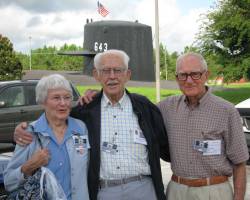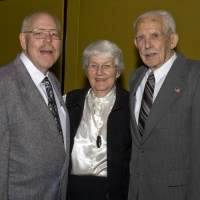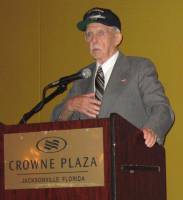
Dorothy & Richard with Captain Eaton |

Richard Retin, Chairman with
Dorothy & Richard |

Richard telling us about seeing an American nurse for the first time after being freed as a POW in Japan |
Attending our 2008 Jacksonville - Kings Bay reunion is a true hero from the Old Canopus. Here is Richard’s amazing story:
POW, or Prisoner of War, a term many believe they've come to know, reduces extraordinary circumstances to so little. The exception to that rule is when, over years of use, the abbreviation itself becomes like a word in colloquial language. POW has that distinction.
Barefoot Bay's Richard A. Dennig was a prisoner of the Japanese army and navy for three years during World War II.
His tour was up and his ship was about to go home when war was declared and they literally turned around and headed toward the Philippine Islands.
He was aboard a submarine tender, the USS Canopus, Dennig said at a recent Loyalty Day ceremony in Barefoot Bay .
On Dec. 6, 1941 , with his ship tied at the naval yard near Manila Bay , while on watch duty Dennig received messages that the Japanese had bombed Pearl Harbor . It was early morning for them; he spread the word throughout the ship.
The crew then moved the Canopus to Manila Bay about three days later, Dennig reports. The Japanese bombed Clark Air Force Base outside Manila , taking out B-17s and P40 fighters. According to Dennig, they "...blew almost all of 'em up!"
The Canopus stayed at the pier in Manila Bay and Dennig said the Japanese bombed all around them. The Canopus was spared for the time being.
Dennig, originally from Minnesota , was 21 years old at the time; his rank in the Navy was Storekeeper Second Class.
The crew then took the Canopus southwest of Manila Bay , to Mariveles on the Bataan Peninsula where they docked at a mountain with netting over them for cover. They operated at night there for a time, tending to submarines with everything from re-supply of food and water to repairs as they had a full machine shop on board. They were discovered and the Japanese dropped one bomb directly down the smokestack to the bottom of the ship where he said it took out the propeller shaft, disabling her.
Orders came in to surrender Bataan Peninsula to the Japanese and the Philippines were ordered to surrender.
On April 8, 1942 the crew took the Canopus out in the waters between Corrigador Island , and the Bataan Peninsula , opened all the valves and sank her, Dennig said. As far as Dennig knows, Canopus is still there.
Dennig said most of the sailors got on motor launches to the small mountainous island of Corrigador where they were to defend their side with machine guns against a Japanese landing. There is only about four miles between the Peninsula and the island they were defending. He said it took the enemy three to four days to take them.
At first they were taken to an airfield and stripped of everything but their clothes, then taken to Manila on motor launches where they were unloaded in waist-deep water and paraded down the streets of downtown Manila , Dennig said.
They were then taken to Bilibib prison for three days and finally put on cargo ships.
Dennig said some Japanese submarines carrying American POWs may have been sunk by the U.S. forces as they had no way of knowing what they were carrying. He was on the upper deck of a Japanese ship that was "shelled" and missed.
Dennig said he was then taken by Japanese cattle boat to Osaka , Japan . The trip lasted, he said, about three weeks where they were kept in the hold. It was so crowded there was not even room to sit let alone lie down.
Dennig said nine or 10 of the men died on the trip and were buried at sea.
They arrived at Osaka prison camp Umeda Bunsho on Thanksgiving Day 1942.
There were 400 American Army, Navy and Marines there.
There was a great deal of abuse for minor infractions at the camp, he reported in a document of his testimony taken after his return to the United States at the United States Naval Center in Idaho .
The document testifies to many cases of abuse and improper treatment of prisoners of war, including Japanese officer names. It states that by 1945, of the over 400 men originally taken prisoner at that camp, "...approximately 130 of them had died due to malnutrition and disease."
The second camp Dennig said he was transferred to was at Tsuruga , Japan , where they loaded and unloaded boxcars and ships. Here his testimonial document details more physical abuse by Japanese soldiers as well as abuse of Red Cross supplies.
"The Japanese had parties on the Red Cross food that the Americans had sent for our relief," Dennig said.
By then, Dennig said, the Americans were doing a good job going north.
"They came with incendiary bombs, the very first one hit our building!" He said most of them got in the water and ducked under, not that it would have saved them from a direct hit.
As the U.S. burned the entire town, about a mile and a half, he said, they were moved two miles back and had to walk those miles to and from the loading area daily. This continued until Japan surrendered.
With the worst of his ordeal over, Dennig was finally returned home, where his parents, his sister and her best friend, Dorothy, were eagerly waiting for him. His mother had painstakingly kept a scrapbook of every letter from him, or about him and every piece of mail from the military during and at the end of his ordeal, as well as newspaper clippings.
His sister's best friend later became his wife and they have shared more than 50 years of marriage.
Dennig re-enlisted in the Navy until he retired with numerous awards for his varied achievements.
Recent article about Richard in his local newspaper, TC Palm: 
I scanned to PDF several documents from his wartime experience scrapbook:
Prisoner of War Story  |
Testimony of Richard Denning  |
Report of American Prisoners  |
Dedication of American Prisoners of War Memorial  |
Canopus Courageous  |

|
